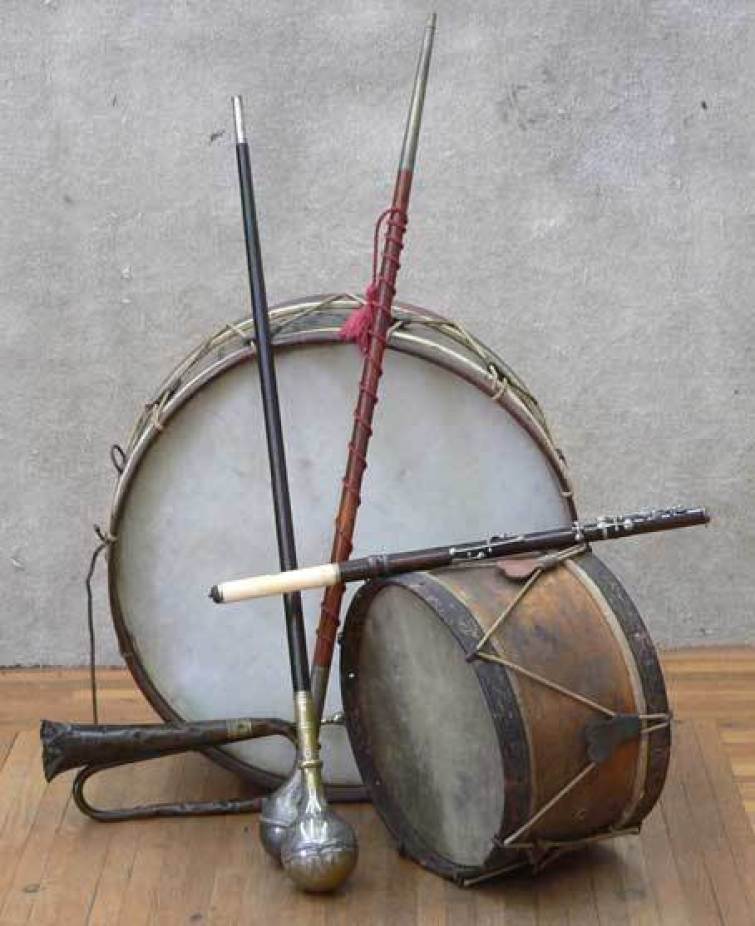Your cart is currently empty!

The Stonewall Brigade Band
The Stonewall Brigade Band was created prior to the Civil War, over a hundred and fifty years ago. It is now a community band that calls Staunton, Virginia home and is the oldest continuous community band in the nation.
In 1854, David W. Drake organized a musical association in Staunton for its citizens. This musical association would later become known as the Stonewall Brigade Band, and Drake as its founder.
The first formal concert was held on July 17, 1857, a Friday night, at Union Hall on Beverly Street in Staunton. The concert led to the band being contracted for a band wagon, an indispensable adjunct to any organization that was to lead parades, granting the band the mobility to move for many miles and up many hills. The lavishly decorated wagon appeared in town in early 1858.
The musical association’s official name became the Staunton Mountain Sax Horn Band, though it was also referred to as Turner’s Silver Cornet Band. Under both names the band continued to play in Staunton and on tours to distant areas all the way up until the Civil War. Through the West Augusta Guard and the Staunton Artillery, activities were shared with the band.
In 1859, Turner’s Silver Cornet Band purchased the first set of musical instruments to become organizational property – horns of German silver manufactured by Antoine Sax of Brussels, Belgium and imported by Clemm and Brothers Philadelphia. These horns were among the instruments that survived the Civil War and were brought back home with the band from Appomattox.
Many of the band members departed in the troops that set off for Harper’s Ferry. Once under the command of Col. Thomas Jonathan Jackson, the only instruments allowed were the drum and bugle. The eight companies of Augusta County and two Frederick County units combined to form the Fifth Regiment of Infantry and became Jackson’s marching brigade. Soon after, reference was made to the Fifth Regiment Band and then, in April 1862, the band – including buglers, drummers and other musicians – came into existence as a distinct unit on the regimental roster carried on company rolls.
The band did more than entertain. During the Winchester Campaign, the Fifth Regiment Band attained distinctive battlefield functions. The band members served as combat riflemen, hospital corpsmen, litter-bearers after battles and assisted in field hospitals non-surgically. They were also utilized as couriers.
On April 12, 1865, the Stonewall Brigade – completing its record of active participation in 39 major battles – laid its battle flags on the grass, stacked arms, and left the field of combat. At the war’s end in Appomattox, the five regiments of the Old Stonewall Brigade mustered 19 officers and 184 enlisted men, of whom only 81 were still armed. The Fifth Regiment of Virginia Volunteers, led by Capt. Peter E. Wilson, carried 47 men on its roster, only 20 of them bearing arms. Company L, Staunton’s West Augusta Guard, had six enlisted men and an officer. Of the Stonewall Brigade Band, seven were left to surrender at Appomattox.
The band wagon had managed to escape disaster and remained with the regiment. In accordance with the terms of surrender which granted the retention of personal and individual possessions, the band members were able to keep their musical instruments and brought them back to Staunton. Today, they are enshrined at the Stonewall Brigade Band Hall. Some of the band’s original sheet music still exists as well.
Along with their instruments, the Stonewall Brigade Band preserved its organization and retained its proud name through the four long years of war. Within a year of the war’s conclusion, the band resumed performances at Staunton’s traditional community festivities and again resumed its political aloofness.
Through the ages, they performed at weddings, celebrations, funerals, for civil and patriotic organizations, parades, banquets, concerts, baseball games, reunions, World Fairs, commencements, and lawn parties. Some of the highlights over the past century and a half include playing in President Ulysses S. Grant’s funeral procession in New York City in 1885; the cornerstone laying of the Robert E. Lee monument parade in Richmond, Virginia in October 1887, the dedication of the Confederate monument at Thornrose Cemetery in Staunton on September 25, 1988 amidst a crowd of 4,000; the Washington Centennial in New York City in 1889; sponsoring the United States Marine Corp Band in 1890; the dedication of Stonewall Jackson’s monument unveiling in Lexington, Virginia on July 21, 1891; Confederate President Jefferson Davis’ interment at Hollywood Cemetery in Richmond on May 30, 1893; President Grover Cleveland’s inaugural parades in 1885 and 1893; the Columbian Exposition at the World’s Fair in Chicago in October 1893; President McKinley’s inauguration in 1897; playing for the unveiling of the Thomas Jefferson monument in Charlottesville, Virginia in 1902; President William H. Taft’s inaugural parade in 1909; and President Woodrow Wilson’s inaugural parades in 1913 and 1917.
Today, the Stonewall Brigade Band has a permanent home at 600 Thornrose Avenue in Staunton near Gypsy Hill Park, where the band can often be seen performing in the Stonewall Brigade Bandstand. Each summer the band presents a free summer concert series along with an annual Christmas concert. You can find a full concert schedule on the band’s webpage, www.stonewallbrigadeband.com.

Leave a Reply